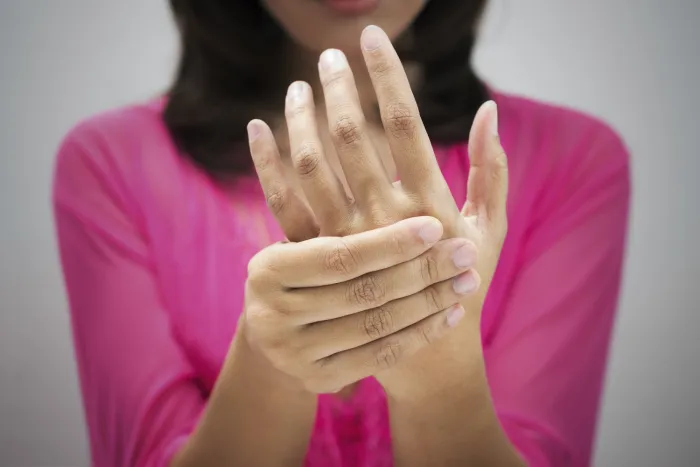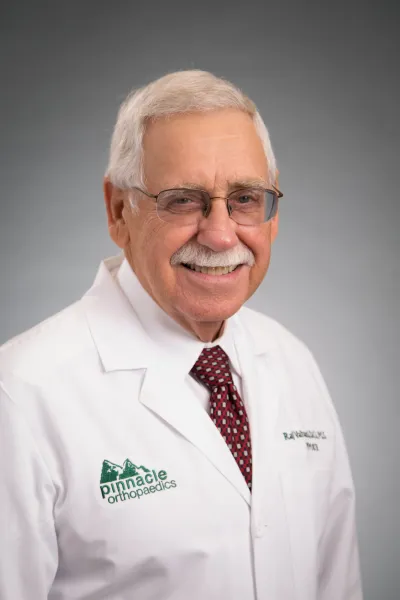
Hand and Wrist

Hand and Wrist Conditions and Treatments
The hands and wrists are one of the most used and relied on body parts for everyday tasks. They provide the body with the flexibility to hold, handle, and control objects. You use them day in and day out一from sipping your coffee in the morning to brushing your teeth at night.
More importantly, this part of your body proves to be the most useful when it comes to sports, work, and other strenuous activities. But unfortunately, repetitive stress can compromise the health of your hand and wrist, exposing them to different kinds of injuries and conditions.
But the good news is that Pinnacle Orthopaedics specializes in the care and treatment of the hand and wrist一from musculoskeletal disorders to sports injuries.
Below, our leading hand surgeon will discuss everything there is to know about common wrist and hand conditions, common causes, and treatment options.
Anatomy of the Wrist and Hand
The hand and wrist have a highly complex and intertwined structure of 27 bones. It also has 24 muscles and several joints to allow different functions, such as grasp and grip. Some of the main and important structures of these two body parts include:
The wrist is formed by the two prominent bones of the forearm called radius and ulna. The forearm's ulna and radius bones support the muscles that manipulate the bones of the hand and wrist. The rotation of the radius around the ulna results in the supination and pronation of the hand. This gives a hand a broad range of motion.
Furthermore, the wrist serves as the bridge where the bones of the hand and forearms meet, joined by multiple joints that allow movement.
The human hand consists of a broad palm, the metacarpus, with five digits attached to the forearm by a joint called the wrist, or carpus. The back of the hand is formally called the dorsum of the hand. The hand is made up of 27 bones and contains 14 digital bones, also called phalanges (finger bones): two in the thumb and three in each of the four fingers. The carpals directly connect to the wrist joints, while the metacarpals have five tiny bones that comprise the middle part of the hand.
There are eight small carpal bones in the wrist called the carpus. The carpus is slightly concave and forms a canal known as the carpal tunnel through which tendons, ligaments, and nerves extend into the palm. This joins with the metacarpal bones and ligaments.
The five metacarpal bones of the palm extend from the carpus to each of the digits of the hand. The phalange bones form hinge joints between each other. The forearm muscles flex and extend the phalanges by tendons that run through the wrist and hand.
Although well-built, this part of your body can still suffer from different conditions due to overuse, repetitive stress, or trauma. Additionally, aging and an underlying medical condition can also affect your wrist and hand's health.
Common Conditions of the Hand and Wrist
Painful sensations, stinging, burning, numbness, and soreness in the hands and wrist warrant a doctor's visit. If not addressed, these seemingly harmless symptoms might lead to a more severe condition, such as the following:
Carpal Tunnel Syndrome
The carpal tunnel refers to a narrow, tube-like canal on the palm side of the wrist. It serves as the passageway of the tendons and nerves that connect the hand to the forearm. Furthermore, its purpose is to protect the structures inside its "tunnel," specifically the median nerve.
However, it can easily suffer from painful inflammation during repetitive use of the fingers, hands, and wrists. As a result of the swelling, the median nerves become "pinched" or compressed, resulting in painful sensations. This disease is called carpal tunnel syndrome. Its most common signs and symptoms include:
Wrist and hand pain, especially in the thumb, middle, and index finger.
Numbness and tingling feeling.
Weakness in the affected area.
Fortunately, an expert hand and wrist doctor can quickly restore its function through proper rehabilitation and therapy. But for severe cases, a wrist surgeon may opt to perform an endoscopic or open surgical procedure.
De Quervain's Tenosynovitis
De Quervain's syndrome may not be as common as carpal tunnel syndrome, but it can be as painful. This condition refers to an inflamed tendon located at the base of the thumb by the side of the wrist. One of its major symptoms is intense pain in the area during thumb movement or function.
Flexor Tendon Injuries
Flexor tendons refer to elongated tissues originating from the forearms and extending into the small bones of the fingers. Their primary function is to facilitate the bending or straightening of fingers on the palm side.
However, these tendons are located close to the skin's surface, making it prone to deep cuts, tears, and other forms of damage. In addition, injury to the flexor tendon also affects the finger joints, making it impossible to use the affected fingers.
A hand doctor usually recommends surgery in most flexor tendon injuries since tendons cannot heal unless the torn ends are touching.
Hand Fractures
A fractured hand means you have one or more broken bones in the fingers and/or the palm. Fractured bones also affect the nearby soft tissues and nerves, making movement difficult and painful.
This type of injury usually happens due to falls, vehicular accidents, crush or twisting accidents, and direct blows during contact sports. Additionally, studies suggest that hand fractures also have a high prevalence in children, accounting for 2.3% of all ER visits.
Trigger Finger Injuries
A trigger finger occurs when the fingers or thumb gets stuck or "locked" in a bent position. This happens when the bands of tissues holding the flexor tendons suffer from inflammation due to forceful activities. A medical condition, like rheumatoid arthritis, can also cause this kind of injury.
Common symptoms of trigger finger injuries include pain, stiffness, and a popping sensation when you move the fingers.
Wrist Sprains
Wrist sprains commonly happen when you sustain a bad fall onto an outstretched hand. This results in a damaged ligament, which can cause extreme pain, swelling, and bruising.
Most cases of wrist sprains occur in athletes playing highly physical sports. In fact, out of all injuries, hand and wrist sprain is the most common injury for athletes with over 49% prevalence.
Fortunately, you can easily treat mild wrist sprains by resting, icing, compressing, and elevating the affected area. But for severe cases, a wrist surgeon might need to get involved to repair torn ligaments.
When to See a Hand and Wrist Doctor
Mild wrist and hand conditions go away on their own with proper rest and immediate remedies. However, some symptoms may persist for extended periods of time, requiring medical attention and treatment. This includes the following:
Pain or any discomfort even when resting the affected hand.
Pain or discomfort during activity.
Inability to move or limited movement and range of motion.
Swelling, numbness, tingling, and soreness.
Obvious deformity
It is better to consult an orthopedic hand doctor at once during these circumstances, especially for urgent cases, such as fractures and dislocations.
An orthopedic doctor who specializes in treating hand conditions can help solve your ailing problems. Furthermore, these experts can give you a proper consultation, diagnosis, treatment, and preventive measures about your situation.
So if you or someone you know has been suffering from a wrist or hand condition, then seek medical help from a hand surgeon at once.
How Are Hand and Wrist Problems Diagnosed?
Orthopedic doctors diagnose hand and wrist conditions by learning about your medical history, current health, and symptoms. Next, they will conduct a physical examination to know the specific area affected, physical limitations, and state.
In some injuries, a diagnosis may be made after the physical examination. But to be sure, doctors may also order other diagnostic tests and procedures to determine the extent of the damage. This includes:
Xray, computerized tomography (CT) scan, and magnetic resonance imaging (MRI)
Ultrasound scans
Electromyography to measure the electrical activity of the muscles in the hand and wrist. This test can detect abnormalities in the electrical activity caused by certain conditions.
Video fluoroscopy involves using an X-ray and contrast dye to view and highlight the movement of the hands and wrist.
Blood tests to see if there is any inflammation or to rule out other diseases.
Once a proper diagnosis has been made, your orthopedic specialist will discuss your treatment plans, such as your treatment options and rehabilitation.
Hand and Wrist Treatment Techniques
For mild conditions, doctors can resort to conservative approaches, such as splints, hand therapy, and prescription drugs. However, if the disease is already a systemic problem or in its severe phase, then a surgical procedure may be needed.
Hand and wrist surgeons conduct different types of surgical operations depending on your injury or condition. Some examples of hand and wrist surgery include:
Arthroscopy
Wrist arthroscopy involves making tiny incisions in the area to insert an arthroscope (small camera) and other tiny instruments needed. This minimally invasive surgery allows the surgeon to inspect the affected area, remove damaged tissues, and repair the joint.
Arthroscopic procedures may be used to diagnose and treat conditions, such as wrist fractures, chronic wrist pain, ligament tears, and ganglion cyst in the wrist.
Microsurgery
Since the hands consist of tiny structures, your surgeon may also utilize microsurgery to treat traumatic injuries. Microsurgery involves the use of operating microscopes and precision instruments to operate on the soft tissues, blood vessels, and nerves in the hand and wrist.
Closed Reduction and Fixation
Closed Reduction and Fixation is an orthopedic management technique to treat a broken bone without needing open surgery. This involves realigning the fractured wrist or finger and immobilizing it while it heals.
Tendon Repair
Tendons refer to the rope-like tissues that connect the muscles to the bones. The tendons in the hand and wrist may get torn or damaged due to sports injuries, trauma, cuts, or rheumatoid arthritis.
Your hand surgeon can repair your tendons using an arthroscopic procedure or open surgery, depending on the extent of the injury.
Nerve Repair
Traumatic injuries may result in a damaged or severed nerve in the hands or wrist, losing function and sensory abilities. When your condition does not respond to conservative approaches, then nerve repair through surgery may be conducted.
Fasciotomy
Fasciotomy is a surgical procedure that helps relieve the tension or pressure in the hands caused by compartment syndrome. Fasciotomy involves cutting the tissue that surrounds the affected area to bring back normal blood circulation and function.
Furthermore, the procedure may also involve removing damaged tissues to prevent the condition from worsening.
Joint Replacement
Joint replacement involves replacing a severely damaged joint with an artificial one made of silicone, metal, or your body's own tendons. Surgeons conduct this operation to treat and relieve the symptoms of hand arthritis.
Surgical Drainage and Debridement
Hand infections like cellulitis, paronychia, and felon are treated through surgical drainage and/or debridement. A surgical drain involves draining and removing the accumulated pus in the infection site.
For severe infections, a surgeon may use surgical debridement. This involves the surgical removal of dead and infected tissues, cleaning foreign debris, and thoroughly disinfecting the affected area.
Some surgical procedures may require putting your hand or wrist in a splint or cast to keep it immobile while healing. Furthermore, your doctor may also prescribe you to work with a physical therapist to help augment your recovery process. Additionally, this will also help build your strength back and improve your hand's range of motion and flexibility.
Specialized Orthopedic Care and Treatment at Pinnacle Orthopaedics
If you are looking for a board-certified hand and wrist doctor, then stop Googling "orthopedic near me" anymore because you have found it!
At Pinnacle Orthopaedics, we provide the highest quality of orthopedic care to patients through our innovative surgical and non-surgical treatments. We have Fellowship Trained and Board Certified Physicians who specialize in the care and treatment of the hand and wrist.
Our team focuses on hand and wrist issues, from acute injuries to chronic problems. They diagnose and treat musculoskeletal disorders, including the bones, joints, ligaments, and muscles.
Our Hand and Wrist team performs procedures, treats sports injuries, and repairs trauma of the hand and wrist using the most advanced knowledge and treatment. Our Wrist and Hand Center focuses on a continuum of care between the physician and the rest of the healthcare team in order to return the patient back to their prior level of function as quickly and safely as possible.
Get a proper consultation for your condition by giving us a call at 770-427-5717 or submitting a contact form. You can also visit one of our orthopedic clinics conveniently located near you:
The material contained on this site is for informational purposes only and DOES NOT CONSTITUTE THE PROVIDING OF MEDICAL ADVICE, and is not intended to be a substitute for independent professional medical judgment, advice, diagnosis, or treatment. Always seek the advice of your physician or other qualified healthcare providers with any questions or concerns you may have regarding your health.







